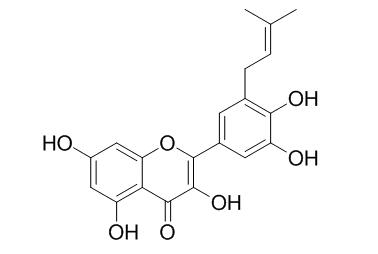Uralenol
Uralenol significantly shows the inhibitory activities against the PTP1B enzyme; it also shows inhibitory activities on mushroom tyrosinase using l-tyrosine as substrate(IC50 =49.5 uM). Uralenol shows potent anti-proliferation effects on ER-positive breast cancer MCF-7 cells in vitro.
Inquire / Order:
manager@chemfaces.com
Technical Inquiries:
service@chemfaces.com
Tel:
+86-27-84237783
Fax:
+86-27-84254680
Address:
1 Building, No. 83, CheCheng Rd., Wuhan Economic and Technological Development Zone, Wuhan, Hubei 430056, PRC
Providing storage is as stated on the product vial and the vial is kept tightly sealed, the product can be stored for up to
24 months(2-8C).
Wherever possible, you should prepare and use solutions on the same day. However, if you need to make up stock solutions in advance, we recommend that you store the solution as aliquots in tightly sealed vials at -20C. Generally, these will be useable for up to two weeks. Before use, and prior to opening the vial we recommend that you allow your product to equilibrate to room temperature for at least 1 hour.
Need more advice on solubility, usage and handling? Please email to: service@chemfaces.com
The packaging of the product may have turned upside down during transportation, resulting in the natural compounds adhering to the neck or cap of the vial. take the vial out of its packaging and gently shake to let the compounds fall to the bottom of the vial. for liquid products, centrifuge at 200-500 RPM to gather the liquid at the bottom of the vial. try to avoid loss or contamination during handling.
Molecules.2019, 24(2):329
Res Pharm Sci.2023, 18(3):244-261.
Konkuk University2023, 29:4634721
Braz J Biol.2023, 82:e266573.
Applied Biological Chemistry2023, 66(58):112.
J Ethnopharmacol.2016, 194:219-227
Food Chem Toxicol.2020, 135:110863
Antimicrob Agents Chemother.2020, AAC.01921-20.
Sci Rep.2017, 7:40345
Int J Nanomedicine.2022, 17:6513-6525.
Related and Featured Products
Food Chemistry, 2008, 106(2):529-535.
Tyrosinase inhibitors from paper mulberry (Broussonetia papyrifera)[Reference:
WebLink]
METHODS AND RESULTS:
Fractionation of a chloroform-soluble extract from twigs of Broussonetia papyrifera, led to the isolation of one new compound, 3,5,7,4′-tetrahydroxy-3′-(2-hydroxy-3-methylbut-3-enyl)flavone (1), and 10 known compounds, Uralenol (2), quercetin (3), isolicoflavonol (4), papyriflavonol A (5), broussoflavonol F (6), 5,7,3′,5′-tetrahydroxyflavanone (7), luteolin (8), isoliquiritigenin (9), broussochalcone A (10) and 5,7,3′,4′-tetrahydroxy-3-methoxyflavone (11). Their structures were identified by interpretation of MS, 1H NMR, 13C NMR, HMQC and HMBC data.
CONCLUSIONS:
Their inhibitory activities on mushroom tyrosinase using l-tyrosine as substrate were investigated and the IC50 values of 3,5,7,4′-tetrahydroxy-3′-(2-hydroxy-3-methylbut-3-enyl)flavone, Uralenol, quercetin and broussoflavonol F were found to be 96.6, 49.5, 57.8, and 82.3 μM, respectively, better than arbutin, a well-known tyrosinase inhibitor.
Phytochemistry Letters, 2013, 6(3):331-336.
Prenylflavone derivatives from Broussonetia papyrifera, inhibit the growth of breast cancer cells in vitro and in vivo[Reference:
WebLink]
Two new prenylflavones 5,7,3′,4′-tetrahydroxy-3-methoxy-8-geranylflavone (1) and 5,7,3′,4′-tetrahydroxy-3-methoxy-8,5′-diprenylflavone (2), as well as four known ones, Uralenol (3), papyriflavonol A (4), broussoflavonol B (5) and broussochalcone A (6) were isolated and purified from an ethyl acetate-soluble extract of the barks of Broussonetia papyrifera.
METHODS AND RESULTS:
Their structures were determined with the spectroscopic methods including HR-EI-MS, 1D and 2D NMR. We found that compounds 2–6 showed potent anti-proliferation effects on ER-positive breast cancer MCF-7 cells in vitro. The IC50 values of compounds 2 and 5 were 4.41 and 4.19 μM respectively after the treatment of 72 h. We also found that compounds 2 and 5 strongly down-regulated expression concentrations of estrogen receptor-α (ER-α) and were able to inhibit tumor growth in a xenograft model of the human breast cancer line BCAP-37 in vivo.
CONCLUSIONS:
Our results demonstrated that prenylflavones from B. Papyrifera exhibit potent anti-tumor activity.
Bioorg Med Chem Lett. 2002 Dec 2;12(23):3387-90.
Natural PTP1B inhibitors from Broussonetia papyrifera.[Pubmed:
12419367]
METHODS AND RESULTS:
Two new compounds, 8-(1,1-dimethylallyl)-5'-(3-methylbut-2-enyl)-3',4',5,7-tetrahydroxyflanvonol (1), 3'-(3-methylbut-2-enyl)-3',4',7-trihydroxyflavane (2) and three known compounds 3,3',4',5,7-pentahydroxyflavone (3), Uralenol (4), broussochalcone A (5) were isolated from the roots of Broussonetia papyrifera, and their structures determined by spectroscopic methods.
CONCLUSIONS:
Compounds 1, 3, 4 and 5 significantly show the inhibitory activities against the PTP1B enzyme.



